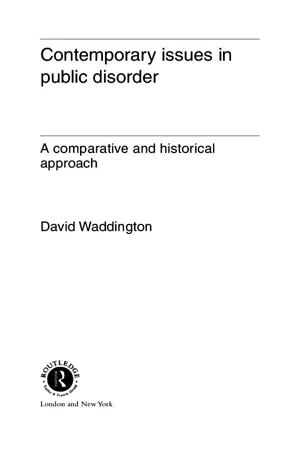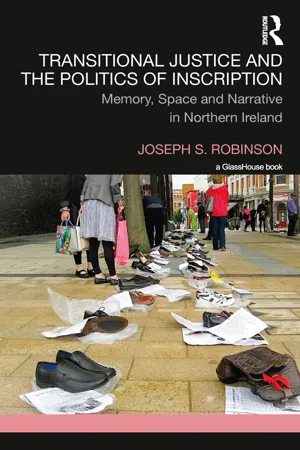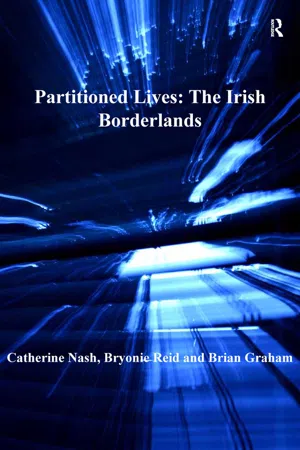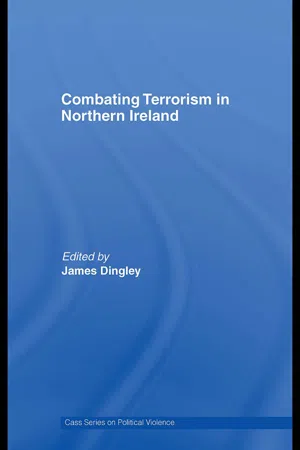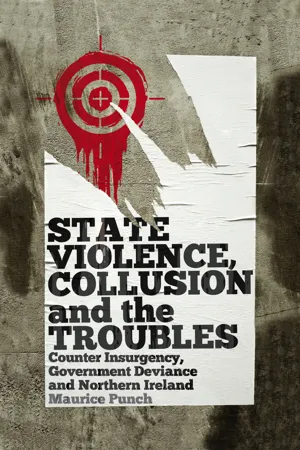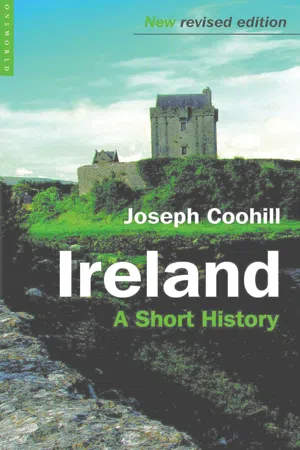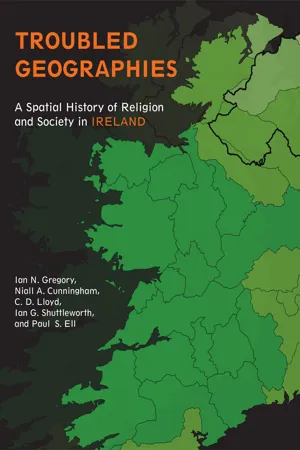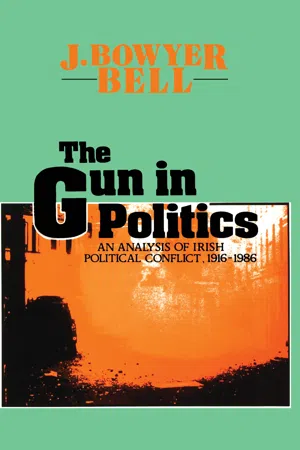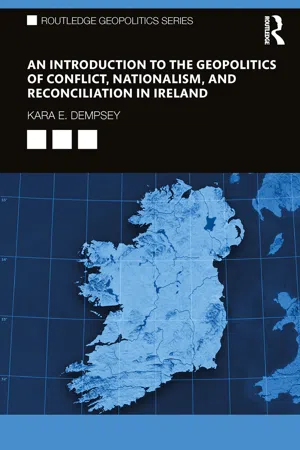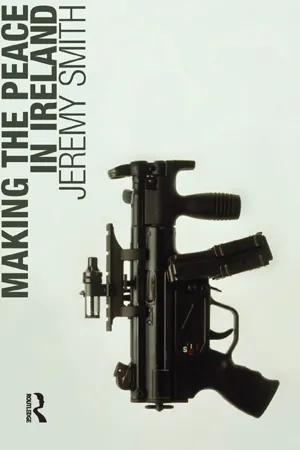History
Troubles in Northern Ireland
The Troubles in Northern Ireland refers to a period of conflict and violence primarily between the nationalist Catholic community, who sought a united Ireland, and the unionist Protestant community, who wanted to remain part of the United Kingdom. Lasting from the late 1960s to the late 1990s, the Troubles resulted in thousands of deaths and had a profound impact on the region's political and social landscape.
Written by Perlego with AI-assistance
Related key terms
12 Key excerpts on "Troubles in Northern Ireland"
- eBook - ePub
Contemporary Issues in Public Disorder
A Comparative and Historical Approach
- Dr David Waddington(Author)
- 2002(Publication Date)
- Routledge(Publisher)
Chapter 7
The ‘Troubles’ in Northern Ireland
This chapter sits uncomfortably in a book about public disorder. Some might argue that it would be more appropriate to treat the recent ‘Troubles’ in Northern Ireland (from 1968 to the present) as an example of guerrilla or civil warfare. One reason for including them here is that the bombings and assassinations of today are the legacy of the civil disturbances of the 1960s. As such, the escalating conflict in Northern Ireland offers a useful paradigm for predicting whether a similar process of escalation might feasibly occur on the British mainland. A second reason is to show how recent British security developments are based on precedents set during the containment of the Irish conflict.The chapter begins by examining the historical roots of the present Troubles. It then traces the development of the conflict from the seminal activities of the Catholic civil rights protest of 1968 to the introduction of the British Army in 1972. A third section documents and analyses the increasingly repressive role played by the security forces and the corresponding violence employed by insurgent civilian paramilitary organisations. Finally, the chapter evaluates the likelihood of recent patterns of conflict in Northern Ireland being reproduced elsewhere in Britain, and briefly explains how the security approach developed in the ‘orange state’ has served as a model for British police practices.A TROUBLED PAST
The present Troubles in Northern Ireland are the most recent manifestation of a centuries-old history of conflict. Between the twelfth and seventeenth centuries, a succession of English monarchs made a series of expansionist forays into the neighbouring country of Ireland. As early as AD 1250, Norman leaden had subjugated most of Ireland’s Gaelic population. Fifty years of guerrilla-style rebellion by the Gaels gradually reduced the amount of territory controlled by the invaders to a small enclave around Dublin, known as the Pale. There settlers established the earliest English plantation in Ireland. - eBook - ePub
Transitional Justice and the Politics of Inscription
Memory, Space and Narrative in Northern Ireland
- Joseph Robinson(Author)
- 2017(Publication Date)
- Routledge(Publisher)
Memory relates directly to only a subset of the methods and practices that legal scholars and political scientists recognise as part of transitional justice – that is, to the so-called backward-looking, not the forward-looking processes” (2013, p. 6, original emphasis, referencing Offe, 1996). Stan may be correct, but only correct inasmuch as she accurately but ironically describes the failings of transitional justice in relation to its treatment of memory. How individuals, groups, and societies remember a difficult, contentious, and traumatic past is of the utmost significance in accurately tracing the contours of present and future possibilities.The Troubles in Northern IrelandThis section hardly purports to reinvent the proverbial wheel. Many readers will be aware that there are a litany of excellent histories of modern Ireland, Northern Ireland, and the Troubles, and for those interested in more detail, context, and analysis of the Troubles and the history of modern Ireland, I do not hesitate to direct them elsewhere (for general histories, see Jackson (2014), Cochrane (2013), McKittrick & McVea (2001), Ó Dochartaigh (1997); for modern Irish republicanism/nationalism, see Bean (2007), Murray & Tonge (2005), Moloney (2002); for modern loyalism, see the perspectives in McAuley & Spencer (2011), Spencer (2008); and for unionism’s relationship with loyalism, see Southern (2007)). This section is intended purely to provide readers unfamiliar with Northern Ireland with a context and a backdrop for my arguments throughout the book.Writing history in modern Ireland can be a fraught endeavour. History in Ireland is often used as an ideological or political weapon, as a means to discursively reproduce an antagonistic, violence-producing, or violence-justifying narrative. By emplacing such a narrative within the realm of historical ‘objectivity’, the production and reproduction of these histories lays claim to unbroken lines of nationhood, oppression, threat, siege, and/or class struggle. In Northern Ireland, these discursive reproductions tend to take three major forms: nationalist (green) histories, unionist (orange) histories, and Marxist (red) histories (Perry, 2013). The first argues that there is a coherent, historical polity called Ireland/Éire, and a people describable as Irish/Éireannach, that was severed by British colonialism. The second argues that there are two distinct political, ethnic, and/or religious communities on the island, and that the conflict has historically been caused by the refusal of one community (nationalists) to recognise this. And the third sees British imperialism and policy as stemming from its inseparability from the imperatives of capital and capitalists and, generally, sees greater hope for a socialist state under an Ireland free from British imperialism. However, Marxist perspectives on Ireland tend to view both nationalism and unionism as ‘false consciousness’ (for example McCann, 1993). These frames are all ubiquitous in Northern Ireland and they provide a reservoir from which ‘chosen traumas’ and ‘chosen glories’ can be selectively recalled as a means of political mobilisation and social cohesion (Volkan, 1997). - eBook - ePub
- Catherine Nash, Bryonie Reid(Authors)
- 2016(Publication Date)
- Routledge(Publisher)
Chapter 4The Troubles, the Border and Borderlands, 1969–1995
The nature and experience of the Irish border were deeply altered by the Troubles that stretched from the earliest signs of violence in 1969 to c.1994 when, following the IRA ceasefires of that year, many border roads were re-opened. This marked the beginning of the end to, rather than the cessation of, violence as a protracted peace process was negotiated, culminating in the 1998 Belfast or Good Friday accord. Ultimately, this had to be further renegotiated at St. Andrews, Scotland, in 2006, preparing the ground for a mandatory coalition government in Northern Ireland and power-sharing between the two political polarities, the Democratic Unionist Party and Sinn Féin. In the decades of violence, some 3,700 people lost their lives. The origins of the Troubles were apparent in the late 1960s as signs of renewed discontent with the status quo of unionist dominance in Northern Ireland were evident. In 1967 the Northern Ireland Civil Rights Association was founded to challenge discrimination against Catholics in employment and social housing allocation and held its first sit-ins and protest marches in 1968, becoming particularly active in Derry. Loyalists and the RUC responded heavy-handedly and, in one notorious incident at Burntollet Bridge near Derry in 1969, marchers were ambushed by significant numbers of B Specials, stoned and beaten, in collusion, it is alleged, with the RUC. Fierce rioting broke out in Derry and Belfast. Initially, the moribund IRA was unable to offer any effective protection to Catholic communities who felt themselves under threat from Protestant civilians and paramilitaries and the security forces, including the British Army (initially deployed to protect them). A power struggle within republicanism saw the emergence of the Provisional IRA which rapidly established itself as the most significant challenge to the Northern Ireland and British governments. In the early 1970s, direct rule from Westminster replaced the unionist dominated Stormont parliament and subsequent attempts to establish a power-sharing executive soon collapsed in the face of loyalist opposition.1 - eBook - ePub
- James Dingley(Author)
- 2008(Publication Date)
- Routledge(Publisher)
In many ways not much has changed in 200 years. Since its inception in 1921 Northern Ireland has largely been content to settle down to a mutually agreed segregation between Catholic/Nationalism and Protestant/Unionism. At first some serious moves were made to include Catholics in to the State, 26 but these were dropped almost by mutual consent and the Province settled down to a segregated and sectarian life, both sides defining their own space and territory. The result was that two worlds almost incomprehensible to the other emerged, with little contact and opposed interests and identity. 27 Each eyed the other suspiciously and kept a constant eye open for infringements of its space. Nationalists kept up an anti-state rhetoric without ever having the political clout to do anything about it, while Unionists had control of the state but were always reminded of a Nationalist threat too big to ignore. Analysing the ‘troubles’ To those not familiar with Northern Ireland the ‘troubles’ over the last 37 years seem something of a mystery, even the partition of Ireland appears a mystery to outsiders. Why should a small island of only around five million people be so divided and why should the one and a half million population of Northern Ireland be further divided? These, of course, are fundamental questions, and ones that go to the heart of many other conflicts around the world, the former Yugoslavia being a good example, with its bitter conflicts and divisions over the past 15 years, or the sectarian violence in Indonesia, Sri Lanka or the Basque Lands. Failure to answer these questions has often been at the heart of failing to resolve these conflicts either at the military or political level - eBook - ePub
State Violence, Collusion and the Troubles
Counter Insurgency, Government Deviance and Northern Ireland
- Maurice Punch(Author)
- 2012(Publication Date)
- Pluto Press(Publisher)
3
Roots of the Troubles: Emergency Context: Conspiracy?
We are NOT British, WE ARE IRISH. We will not willingly serve under British rule. England for the English and Ireland for the Irish. Is that unreasonable? (IRA spokesperson). (English 2004:126)During a 30-year period (1968–98), Northern Ireland experienced prolonged turbulence and extensive violence in a form of civil strife. The Troubles cost some 3,800 lives with an estimated 40,000 people injured (McKittrick & McVea 2001). Many families – of police officers, soldiers, members of the emergency services, politicians, judges, paramilitary activists and of ordinary people with no involvement in the conflict – suffered variously from death or injury to a relative or close acquaintance, to having a relative incarcerated, to being forced to move home and/or to experiencing long-term psychological problems. In this chapter I shall examine the roots of that grim conflict, which caused so much suffering and physical damage, to pose what precipitated it; how did the Province became in effect a ‘war zone’; and what was behind a disturbing range of incidents with persistent reports of state deviance and violence?Those incidents involved especially the fatal shooting in highly suspicious circumstances of suspected IRA insurgents, alleged insurgents and republican/nationalist sympathisers by the police and military together with violence by loyalist paramilitaries against nationalists and Catholics. The phrase ‘shoot to kill’ entered the Northern Ireland political lexicon and was used to refer to the possibility of illegal actions including effectively extra-judicial executions with state collusion. This will be examined in the following chapters. Here I wish to sketch the context in which those controversial incidents took place and raise the issue as to whether or not there is evidence of some form of conspiracy to explain them. - eBook - ePub
International Intervention, Identity and Conflict Transformation
Bridges and Walls Between Groups
- Timea Spitka(Author)
- 2015(Publication Date)
- Routledge(Publisher)
Northern Ireland was born in a state of violence, division and dually constructed antagonistic narratives. The history of the conflict and its interpretations is dependent on the narrative. A Nationalist Irish view describes the conflict as the 800-year “brutal English oppression that has brought nothing but trouble to Ireland” (Dixon 2008). In an opposing narrative, hardline Unionists have broadly described their actions as “using constitutional means to defend themselves against violent Irish Nationalists” (Dixon 2008). Northern Ireland came to be as a result of the Irish War of Independence. In 1916, the Irish parliament declared independence and began a campaign to oust British rule, resulting in the War of Independence. In 1920, the British Parliament partitioned Ireland into the North and the South. In the South, the partitioning sparked a civil war, eventually resulting in the establishment of the Republic of Ireland. In the North, the British established rule from London, a “home rule” that in the eyes of many discriminated against the Catholic population and eventually sparked the violent “troubles.” Hardline Unionists, or those who favored integration with the British union, exploited the threat from the IRA to justify discrimination and violence against the Nationalists. Nationalists, or those who traditionally supported a united Ireland, used the political and economic discrimination against the Catholic population to justify revolt and Republican violence.Depending on the focus of analysis and its interpretation, the conflict in Northern Ireland has been portrayed academically as a sectarian conflict stemming from ethnic and religious divides, an economic/political dispute linked to unjust economic and political practices, or a territorial dispute between Britain and the Republic of Ireland (Clayton 1998; McGarry and O’Leary 1995). Most commonly, the conflict has been constructed as a sectarian or an ethnic conflict that marked the divide between the Protestant (British) and the Catholic (Irish) populations (Bruce 1986; Stringer and Robinson 1991). The majority of the sectarian interpretations have understood identity to be salient and permanent, and regarded religion as the ultimate dividing line between the groups. The interpretation of the root causes of the conflict has been directly related to the type of external processes and strategies. This background draws attention to the differing narratives and interpretations of the conflict as constructed and disputed by the diverse leaderships and among academia.Although often categorized as a sectarian struggle, the conflict in Northern Ireland can better be understood as a dispute over two contested national identities: unionism versus nationalism (McGarry 2001; McGarry and O’Leary 1995). The Unionists (mostly Protestants) prefer Northern Ireland to remain in Britain while the Nationalists and the Republicans (mainly Catholics) wish Northern Ireland to be linked to the Republic of Ireland. As noted by numerous surveys, important differences also exist within and between “British” unionism and “Irish” Nationalism. Among those who see themselves as British, a notable minority do not describe themselves as Unionists. Not all Catholics identify themselves as Nationalists and claim territorial identity with the rest of Ireland (Hayes and McAllister 1999). Also, not all Protestants perceive themselves as British or adopt a Unionist label. A sectarian or religious struggle depiction also does not give space to the shifting of meaning or ethnic salience. - eBook - ePub
The Northern Ireland Troubles in Britain
Impacts, engagements, legacies and memories
- Graham Dawson, Jo Dover, Stephen Hopkins(Authors)
- 2016(Publication Date)
- Manchester University Press(Publisher)
Introduction: The Northern Ireland Troubles in Britain: impacts, engagements, legacies and memoriesGraham Dawson and Stephen Hopkins
This book addresses a paradox: that the Northern Ireland conflict, commonly known as ‘the Troubles’, has had profound and shaping impacts upon politics, culture and the lives of many thousands of people in Great Britain, producing lasting legacies that continue to resonate nearly half a century after the eruption of political violence in 1968–69; but that engagements with the conflict, and with its ‘post-conflict’ transformation, from within Britain have been limited, lacking, frequently problematic, often troubled, in ways that are not fully grasped or considered.Some impacts of the conflict ‘in and about Northern Ireland’1 upon Britain may be signalled by some stark figures. The military deployment of British armed forces, known officially as Operation Banner, lasted thirty-eight years, from 14 August 1969 to 31 July 2007. One of the British Army’s most senior officers during that period, General Sir Mike Jackson, has described it as ‘one of the most important campaigns ever fought by the British Army and its fellow Services … the longest to date [and] one of the very few waged on British soil’.2 Over 250,000 Regular Army soldiers served in Northern Ireland during the campaign, with a peak deployment of 28,000 at the peak of the campaign during the summer of 1972.3 A total of 1,441 members of the UK’s armed forces died ‘as a result of operations in Northern Ireland [NI] or … Irish Terrorism … outside of NI’, of whom 874 were members of the Regular Army and other services (excluding regiments recruited from Northern Ireland); of these, 507 died due to ‘Terrorist action’ and 367 from other causes.4 A further 6,307 military personnel were injured.5 The British Army was responsible for killing 301 people during the conflict, of whom 158 were civilians, all but twenty of them Irish Catholics, and 104 were members of the Provisional Irish Republican Army (PIRA).6 Between 1973 and 1997, the PIRA’s bombing campaign in England resulted in over 500 recorded incidents in which 115 people were killed and 2,134 people were injured – often seriously – many of whom were civilians.7 In total, nearly 17 per cent of all those who died in the conflict were from Great Britain, and ‘many more have been affected including relatives, friends and colleagues of the dead and injured, witnesses of incidents, those who have been psychologically affected, and members of the emergency services’.8 Further human costs of the conflict can be discerned in figures relating to the Prevention of Terrorism Acts (1974, 1978), which gave the British police emergency powers of arrest, detention and exclusion under which more than 55,000 people had been interviewed by the mid 1980s and 6,932 people were detained between 1974 and 1990.9 - eBook - ePub
Ireland
A Short History
- Joseph Coohill(Author)
- 2014(Publication Date)
- Oneworld Publications(Publisher)
Like the traditional nationalist view, however, the unionist view can be seen to have supporting evidence from a certain reading of history. One of the central ideas of this school of thought is that Northern Ireland and Northern Irish identity were constantly under threat from the south. Not only did the partition arising from the Anglo-Irish Treaty result in a civil war in the south, it occasioned much anti-partition rhetoric and violence in the decades following it. The IRA attacked Northern Ireland from the south in two major campaigns (1921–2 and 1956–66). The Éire constitution of 1937 laid claim to Northern Ireland, and there was much anti-partition propaganda in the Republic up until the late 1950s. But the traditional unionist view also reassessed some of its main ideas in the last few decades of the twentieth century. In the late 1960s, some unionists began to think that the Troubles were not so much the fault of the southern nationalists as they were of northern nationalists.A.T.Q. Stewart, for instance, argued in his 1977 Narrow Ground: Aspects of Ulster, 1609–1969 that the cause of the Troubles lay within Northern Ireland, and had been there since the beginnings of plantation and the initial clash of cultures (which, he argues, never really stopped).Unlike the traditional nationalist interpretation (which has been successfully revised, with that revision being accepted by most nationalists), the traditional unionist interpretation remains strong in that community. This strength is mostly found amongst politicians and unionist activists, such as Ian Paisley, rather than amongst academics, within Northern Ireland. Many commentators argue that these unionists see themselves as a community under siege, and therefore, they hold on to this traditional interpretation (as well as other traditions, such as marches and parades) in order to retain their identity. Traditional unionists also argue that the unionist cause is supported by purely Northern Irish rather than British interests. In other words, unionists have their own reasons to wish to remain in the United Kingdom, whether or not those are shared by the people in Great Britain. These are based on three main grounds: economics, nationality and religion. Most traditional unionists think that the British economy is, in the long term, more stable and prosperous than the economy in the Republic (despite their prosperity in the 1990s and the prospect of a more unified European economy in the twenty-first century). Northern Ireland, therefore, would be better off in the British economy. Nationality, however, is more important to unionists than economics. Although they have been in perpetual fear of being sold out by a British government seeking a final solution to the problem of Northern Ireland, they have generally thought of themselves as British (in addition to being Northern Irish). Further, they find great psychological links with Britain which seem to transcend politics and economics. Finally, and most importantly, traditional unionists cling strongly to the belief that the only way that their Protestantism can be successfully defended in Ireland is for Northern Ireland to remain separate from the Republic. This goes beyond fearing discrimination on specific issues in a united Ireland with an overall Catholic majority. It is a perception that the Republic is a Catholic country with a Catholic atmosphere, and that Protestants would be perpetual second-class citizens there. - eBook - ePub
Troubled Geographies
A Spatial History of Religion and Society in Ireland
- Ian N. Gregory, Niall A. Cunningham, C. D. Lloyd, Ian G. Shuttleworth, Paul S. Ell(Authors)
- 2013(Publication Date)
- Indiana University Press(Publisher)
Communal Conflict and Death in Northern Ireland, 1969 to 2001
10The conflict in Northern Ireland known as the Troubles started in the late 1960s and largely ended following the Good Friday or Belfast Agreement of 1998, although a decade later violence continued to occur, albeit at a much reduced level. The violence led to over 3,500 deaths. This could be argued to be a small figure, far outweighed in importance by other causes of death such as cancer and heart disease. Even as a percentage of the population it may seem small, coming to only 0.23 percent of Northern Ireland’s population. If this seems like a small figure, however, its numerical significance can be shown by calculating what this would mean if it were applied to British or U.S. populations. A similar death rate in Britain would lead to approximately 130,000 deaths, which equates to the loss of a town like Brighton or Peterborough. In the United States, with its larger population, the equivalent would be approximately 500,000 deaths, comparable to total U.S. military deaths in World War II. From this perspective, it is clear that conflict and violence have led to significant numbers of deaths in Northern Ireland. Moreover, as we will demonstrate, conflict-related killings were geographically concentrated in certain places, including parts of Belfast, some sections of mid-Ulster, and rural areas near the border such as south Armagh. This meant that the direct traumatic impact of the conflict was disproportionately felt by a relatively few communities.This unevenness of experience has heightened and concentrated the local consequences of violence. Some communities are still struggling to overcome the legacy of historic conflict and ongoing sectarianism, itself a current cause of bad community relations and an overhang from the past. Other communities have only felt the results of violence indirectly. Thus, in addition to the geographies of religion, identity, and politics identified in much of this book, this chapter explores a directly linked geography of violent death. - eBook - ePub
The Gun in Politics
Analysis of Irish Political Conflict, 1916-86
- J. Bowyer Bell(Author)
- 2017(Publication Date)
- Routledge(Publisher)
PART III The Ulster Troubles Since 1969: Old Myths, Old Realities, and Alien Perspectives Killing a man is murder Unless you do it to the sound of trumpets. —VoltaireIreland in 1969 was apparently fated to spend the rest of the century living amid interesting times. There was no surprise-free future for those of the secret army gathered before Tones grave in June 1968. The volunteers and veterans would soon go various ways, often into opposing secret armies; their lives disrupted, sacrificed, spent, or wasted in the pursuit of the Republic. A few names would become well known, appearing nightly on the television news not just in Dublin or Belfast but also in New York and Rome and Paris. Some would drift away but never again would the army lack for volunteers or official opponents or alien observers.By the end of1969, the Province of Northern Ireland had become a nexus of turmoil. Each new year seemed to find the level of violence higher, the number of dead greater, the alienation and anguish deeper. Finally, after a decade of rioting, insurrection and reform, random murder and spectacular assassinations, new ballads, new history one-hour television spectaculars and the arrival of droves of analysts and speculators in theories of violence, the Troubles became institutionalized. The level of violence was managed and monitored by the security forces and maintained by the IRA; the Unionists perpetually hovered on the edge of a pogrom, and the governments of Dublin and London sought only the quiet life and a return to politics without the gun. On distant maps in bureaucrats' offices, on the walls of university classrooms and newspaper offices, at the back of volumns on terror and war, Ulster was circled red, a crisis point. Some years the circles might be made thick with greasy wax crayon and others a simple check. But Ulster, Ireland (the Troubles), was always on the butchers list - eBook - ePub
- Kara E. Dempsey(Author)
- 2022(Publication Date)
- Routledge(Publisher)
While violence during the Troubles was concentrated in Northern Ireland, the role of the state, how it framed the conflict, and the larger geopolitical context through which Britain perceived the tumultuous years are significant. During the Troubles, Northern Ireland was “the most dangerous place in the world for a British soldier” (Hennessey 2014, 2). Operation Banner stationed over 27,000 British military personnel in Northern Ireland in what became the army’s longest continuous campaign.Despite this, little information about the Troubles or the socio-political environment that fueled it was available throughout the UK outside of Northern Ireland (e.g., O’Hagan 2018 ). Some of the informational dearth was due to state’s media ban on images and interviews with paramilitaries. Additionally, because many perceived SF as the political wing of the IRA , Thatcher barred all photos and public statements from the republican party.The state-funded British media also overlooked many of NICRA ’s civil rights campaigns or the socio-political discrimination that motivated their protests. Early reporting on the Troubles referred to Northern Ireland as “the province.” The allusion to a remote outpost of the Roman empire revealed how many perceived Northern Ireland as divergent and disparate from the rest of the UK . Arguably:the civil rights era of the late 60s and early 70s has been conveniently overlooked, because it illuminates the fact that the endemic discrimination in Northern Ireland was ignored for decades by successive Westminster governments of every political hue.(O’Hagan 2018)In essence, most British living outside of Northern Ireland believed the Troubles resulted from the IRA ’s archaic and religious struggle to reunite Ireland against the more modern Britain. Appalled, or even apathetic, most interpreted the turmoil as an affront to British self-perception of its democratic and mainly secular culture.Britain during “Direct Rule”
When the state finally decided Stormont and the RUC could no longer control the escalating violence in Northern Ireland, its “Direct Rule” policy in 1972 brought Westminster to the forefront of the power struggle over Northern Ireland. The EU - eBook - ePub
- Jeremy Smith(Author)
- 2014(Publication Date)
- Routledge(Publisher)
27 began speaking once again to a new generation of northern Nationalists.Those ancestral voices were heard loudest within the emergent Provisional IRA. PIRA, or the ‘Provisionals’, or simply the ‘Provos’, were a hardline splinter group from the larger Marxistbased ‘Official’ IRA. Formed in January 1970, it was a coalition of traditional republicans, pledged to establish an Irish republic through armed struggle, and hard-headed Catholic defenders rooted in the northern communities, who saw little point theorizing Marxism when their communities were under attack from loyalist mobs. The Provisionals were, then, a powerful mix of sectarian militancy, community defence and revolutionary fervour, whose aims in the short term were to defend ‘their’ people and in the longer term to undermine Stormont, force Britain out of Northern Ireland and establish a united Irish republic. These objectives were sacrosanct and beyond compromise and since all political activity entailed some compromise, they shunned politics altogether. Armed struggle was the only ‘safe’ route to achieve (and preserve) the purity of their ideals. But armed struggle was reliant upon arms. So through the spring and summer of 1970 the Provos carefully built up support and resources from inside Catholic communities, aided by the growing friction between the army and Catholic communities. Build-up, unlike previous IRA revivals, also now meant propaganda. The Provos carefully nurtured an image of themselves as a legitimate and largely defensive organization, reactive rather than pro-active, and engaged in a colonial conflict against an Imperial aggressor. Their first military action in June 1970, when they defended the small Catholic enclave of Short Strand in east Belfast, centred upon St Matthews Church, was expertly manipulated to convey just these images. Similarly they policed their ‘no-go’ areas, enforced a summary justice within the community, and increasingly orchestrated confrontations with the army to provoke retaliation (or better still over-reaction), to further legitimize themselves in the eyes of the Catholic community and to wider international and especially US opinion to which they appealed. By the autumn of 1970 the Provisionals went on the offensive. It began with a sniping and bombing campaign across the province, claiming in August the lives of two RUC officers. Six months later they turned their guns on the British Army, killing their first soldier, Gunner Robert Curtis, in February 1971. In all, the emergence of the Provos exerted a ‘multiplier’ effect upon the developments unfolding in the region by intensifying Unionist insecurity, widening inter-communal divisions, diverting government resources from reform and turning friction between the army and the Catholic communities to hatred and loathing.
Index pages curate the most relevant extracts from our library of academic textbooks. They’ve been created using an in-house natural language model (NLM), each adding context and meaning to key research topics.
